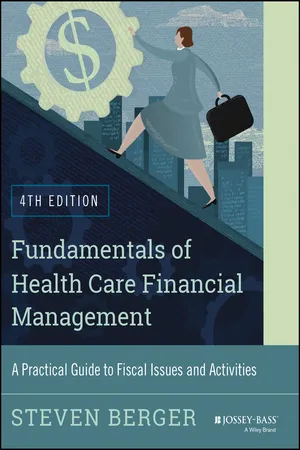
Fundamentals of Health Care Financial Management
A Practical Guide to Fiscal Issues and Activities, 4th Edition
- English
- ePUB (mobile friendly)
- Available on iOS & Android
Fundamentals of Health Care Financial Management
A Practical Guide to Fiscal Issues and Activities, 4th Edition
About this book
In this thoroughly revised and updated fourth edition of Fundamentals of Health Care Financial Management, consultant and educator Steven Berger offers a practical step-by-step approach to understanding the fundamental theories and relationships guiding financial decisions in health care organization. Using cases set in a fictional mid-sized hospital, the book takes the reader into the inner workings of the finance executive's office.
As in the previous editions, this book introduces students to key practical concepts in fundamental areas of financial management. This innovative introduction to the most-used tools and techniques includes health care accounting and financial statements; managing cash, billings and collections; making major capital investments; determining cost and using cost information in decision-making; budgeting and performance measurement; and pricing.
Also covered in depth are the financial implications of Patient Protection and Affordable Care Act, which will increase patient volume, reduce bad debt, factor quality and patient satisfaction into the financial picture, and significantly affect how hospitals and physicians are paid for services.
Students focusing on the business side of health care will find Fundamentals of Health Care Financial Management: A Practical Guide to Fiscal Issues and Activities, 4th Edition a valuable text for understanding the workings of the health care financial system.
Frequently asked questions
- Essential is ideal for learners and professionals who enjoy exploring a wide range of subjects. Access the Essential Library with 800,000+ trusted titles and best-sellers across business, personal growth, and the humanities. Includes unlimited reading time and Standard Read Aloud voice.
- Complete: Perfect for advanced learners and researchers needing full, unrestricted access. Unlock 1.4M+ books across hundreds of subjects, including academic and specialized titles. The Complete Plan also includes advanced features like Premium Read Aloud and Research Assistant.
Please note we cannot support devices running on iOS 13 and Android 7 or earlier. Learn more about using the app.
Information
Chapter 1
January
Learning Objectives
- Recite the massive amount of dollars that flow through the health care industry
- Describe the importance of health care financial management in America
- Explain the role and objective of health care
- Describe the twofold purposes of financial management
- Recognize the categories of providers that make up the health care industry
- Determine how a hospital finance administrator begins to operate within the structure of the annual calendar of finance events
- Build a hospital pro forma financial statement in order to determine if a major project should be approved
“Daddy, what do you do all day at work?” the seven-year-old asks plaintively.“What do you mean?” blinks Samuel Barnes, the daddy.“You know, like when you go out so early in the morning and then don't come back until after other daddies are already home. What are you doing? Why does it take so long?” asks the curly-haired tot.Sam has to think for a moment. “Well, honey, that's a good question. I guess I'm out there trying to make the hospital I work for as successful as it can be.”“But what do you do?”“Susie, I'm in charge of all the money that comes into the hospital. I'm also responsible for all the money paid out to the people who work there. I also make sure that we pay all the other people who send us stuff that we use to make the sick people better, like food and medicine.”“Daddy, do you ever have any money left over after you pay these people?”“Well, Susie, that's the whole point. To be successful, you want to have as much left over as you can.”“But what do you do with all that leftover money? Do you put it in the bank, like I do with my allowance?”“Well, sort of. But instead of putting it into the bank, we put it into a kind of bank that lends it out to other people who need money in their businesses. They then pay us back with a little extra money to thank us for letting them use our money for a while. That's called interest.”“So the hospital has all this leftover money and then you have even more money from these other people paying you interest. I'm glad that you work at a company that's making money because I heard on the news that some people were losing their jobs. I guess you or any of the people you work with won't lose their jobs.”“Actually, Susie, I wish I could tell you it was that clear-cut, but it's not. Part of my job is to make sure that the hospital makes as much money as we decided we wanted to make before the year started. Sometimes that means we believe we will need fewer people working for us if we think fewer people will come to the hospital to be taken care of.”“But,” Susie asks quizzically, “how can you know about all the...
Table of contents
- Cover
- Title Page
- Copyright
- Figures, Tables, and Exhibits
- Preface
- Acknowledgments
- The Author
- Chapter 1: January
- Chapter 2: February
- Chapter 3: March
- Chapter 4: April
- Chapter 5: May
- Chapter 6: June
- Chapter 7: July
- Chapter 8: August
- Chapter 9: September
- Chapter 10: October
- Chapter 11: November
- Chapter 12: December
- References
- Index
- End User License Agreement